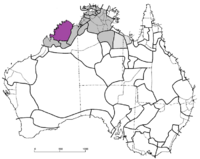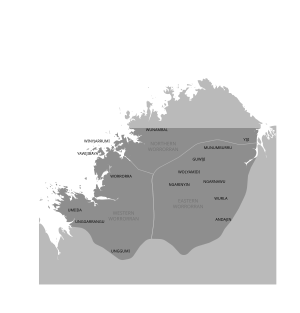Wunambal language facts for kids
Quick facts for kids Wunambal |
|
|---|---|

Worrorran languages (purple), among other non-Pama-Nyungan languages (grey)
|
|
| Region | Western Australia |
| Ethnicity | Wunambal, Kambure, Yeidji, Miwa, ?Wilawila |
| Native speakers | 4 (2021 census) |
| Language family |
Worrorran
|
| Writing system | Latin |
| AIATSIS | K22 Wunambal, K32, K39 |

Map showing Worrorran languages
|
|
The Wunambal language, also called Northern Worrorran or Gambera, is an endangered language from Western Australia. This means very few people still speak it. It has several different ways of speaking, called dialects, including Yiiji, Gunin, Miwa, and Wilawila. The Wunambal people speak this language.
Wunambal is one of three main Worrorran languages. The other two are Worrorra and Ngarinyin. As of 2020, there is a special project to help bring the "Wunambal Gaambera" language back to life.
Contents
What is Wunambal Language?
Wunambal is a special type of language where words are grouped into "noun classes." It belongs to the Northern Kimberley language family. These languages are spoken by the Worrorra people in the north-west Kimberley region of Australia. This area is home to many Aboriginal Australians.
Wunambal is different from most other Aboriginal languages in Australia. It is a polysynthetic language, which means words are often very long and combine many ideas. For example, a single verb can include information about who is doing the action and who it is being done to. All Worrorran languages, including Wunambal, use these noun classes and have verbs that change based on the subject and object.
Wunambal Dialects
Wunambal has several dialects, which are like different versions of the same language. Some of these dialects are:
- Wunambal (the main dialect)
- Gamberre (no longer spoken)
- Kwini (also called Gunin)
- Miwa (no longer spoken)
- Yiidji (also called Forrest River)
- Wilawila (no longer spoken)
- Ginan (no longer spoken)
Some experts believe that some of these dialects might actually be separate languages because they are quite different.
Other Names for Wunambal
The Wunambal language has been known by a few other names and spellings. These include Jeidji, Jeithi, Unambal, Wumnabal, Wunambullu, Yeidji, and Yeithi.
History of the Wunambal Language
The first time Wunambal was written down by researchers was in the early 1900s by J.R.B. Love. Aboriginal people have lived in the Kimberley region for at least 40,000 years. The Wunambal people belong to special family groups that are connected to their land. Their specific land area is called guraa, and it includes both the Wunambal and Gaambera people.
After Europeans arrived, there were about 300 Worrorran people. By 2009, fewer than ten people still spoke the Wunambal language.
Bringing the Language Back to Life
As of 2020, "Wunambal Gaambera" is one of 20 languages chosen for a special project. This project is called the Priority Languages Support Project. It is run by First Languages Australia and funded by the Department of Communications and the Arts. The goal is to find and record languages that are in great danger of disappearing. They want to make sure these languages are documented, especially if no recordings exist, while there are still people who speak them.
Where Wunambal is Spoken
Wunambal was originally spoken by the Worrorra people. These people moved from their traditional lands in the west Kimberley area starting in 1956. The language was spoken in an area stretching from "north of the Prince Regent River" up to "Mt. Trafalgar."
The way Wunambal sounds and its grammar are similar to other Worrorran languages. This is because the people in this area have influenced each other over a long time.
How Wunambal Sounds
There are some small differences in how Wunambal sounds compared to its related languages. These differences can sometimes depend on a person's background. Worrorran languages are known for how they blend sounds together.
Consonant Sounds
Wunambal has different consonant sounds than some other Kimberley languages. It has sounds made with the front of the mouth (alveolar) and sounds made by curling the tongue back (post-alveolar). The language uses stops, nasals, laterals, rhotics (like 'r' sounds), and glides (like 'w' or 'y').
| Around the Lips/Back of Mouth | Front of Mouth | Tip of Tongue | |||
|---|---|---|---|---|---|
| Lips | Back of Throat | Palate | Behind Teeth | Curled Back | |
| Stop | p~b | k~ɡ | c~ɟ | t~d | ʈ~ɖ |
| Nasal | m | ŋ | ɲ | n | ɳ |
| Tap/Trill | ɾ~r | ||||
| Side Sound | ʎ | l | ɭ | ||
| Glide | w | j | ɻ | ||
- Stop sounds can be heard as either soft (voiced) or sharp (voiceless).
- The /r/ sound can be a quick tap or a longer trill.
- The /c/ sound can sometimes be like an 's' sound or a 'ch' sound.
- The /ɡ/ sound can sometimes be like a 'j' sound, especially at the start of a word before a long 'i' sound.
Vowel Sounds
Wunambal has six main vowel sounds: /i/, /e/, /a/, /o/, /u/, and /ɨ/. The /ɨ/ sound is only found in the northern dialect.
- The /i/ and /u/ sounds can sometimes be shorter.
- The /ɨ/ sound can be heard in three different ways.
- The long /aː/ sound can sometimes be heard as a deeper 'ah' sound.
Grammar of Wunambal
In the northern part of Wunambal country, the language has five different noun classes. In the southern part, it has three. These classes help organize words in sentences.
How Words are Built
Wunambal is a polysynthetic language, meaning many parts are added to words to change their meaning. Worrorran languages also have a system where different parts of a sentence agree with each other.
You can find a full list of Wunambal's noun classes and how words change in a book called Notes on the Wunambal language by Arthur Capell (1941).
Sentence Structure
Like all Northern Kimberley languages, Wunambal uses both simple and complex verbs. They often use "auxiliary" verbs (helping verbs) to show who is doing an action and when it happened. For example, prefixes are added to verbs to show the person involved and sometimes the tense. Suffixes are added to show things like how an action is done, the mood, tense, and voice. All Worrorran languages have noun classification, show relationships between words, and have complex ways of forming sentences.
Wunambal Vocabulary
The Northern Worrorran languages share many words with each other.

